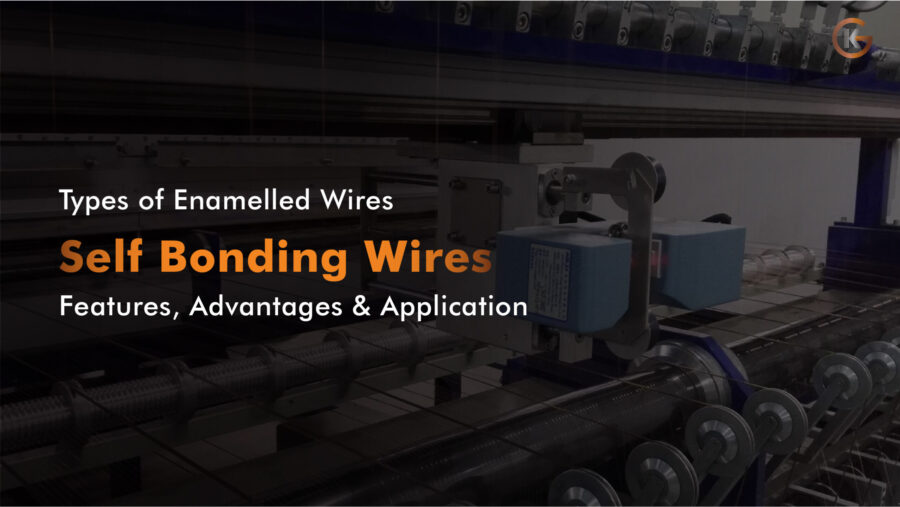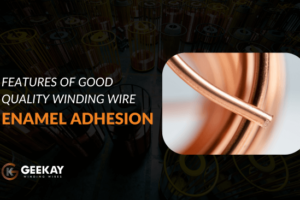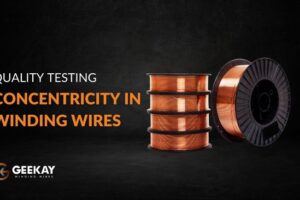Magnet Wire or Enamelled wires, also known as Winding Wires are Copper (Cu) or Aluminium (Al) wires coated with a very thin layer of insulation. They are widely used in the manufacturing of transformers, inductors, motors, generators, speakers, hard disk head actuators, electromagnets, electric guitar pickups and other applications that require tight coils of insulated wire.
Types of Enamelled Wires
Like other wires, magnet or enamelled wire can be classified by the type of enamel used, diameter (AWG number, SWG or millimeters) or area (square millimeters), temperature class, and insulation class.
There are various types of enamels which are used in magnet wires to give them specific properties and make them appropriate for various kind of applications and benefits:
- PU: PolyUrethane
- PE: PolyEster
- PEI: PolyEster Imide
- PAI: PolyAmide Imide
- PI: PolyAmide
- PVF: PolyVinyl Formal
- SL : Self Lubricating
- SB: Self Bonding
Self Bonding Enamelled Wires
In this article, we will discuss Self Bonding Enamelled Wires and their Features, Advantages & Applications.
Self Bonding Enamelled Wires are the wires that allow the transformer coils to be bonded by heating or applying solvent during or after coil winding. These wires have an internal insulation layer & a bonding layer as the outside periphery. These wires are provided with insulation properties at the insulation layer and coil fusion functionality at the bonding layer.
Use of Self Bonding Enamelled Wires may offer advantages over conventional wires in certain winding applications, eliminating the need for bobbins as well as taping or varnishing steps. Activation of the bond coat may be achieved with either heat, or in some cases solvent, or a combination of the two.
Although bond coats may be added to any conventional film, consideration should be given to the re-softening temperature of the adhesive in that it may not withstand the operating temperature of the higher rated primary insulations.
The bondable layer is applied over variety of primary insulation like polyester, polyester-imide, dual coated and solderable polyurethanes of class 130, 155,180 and 200.
There are 3 ways in which this bonding can be done:
Solvent Bonding
Some bond coats can be activated by applying certain solvents during or after the coil winding process. Application of the solvent, usually via saturated wick during winding, causes the bond coat to reflow. The process requires the use of a fixture to hold the coil in place while the solvent is drying. Once dry, the coil should be heated to dry off any residual solvent which might cause long-term coil failure, as well as to complete the bonding process.
Heat Bonding
All bond coats can be heat bonded, either by oven-heating or by directing hot air on to the wire during winding. In either case, the principle is to heat the winding slightly above the bond coat’s reflow temperature and then cool it below its rated bond strength temperature. Oven bonding is accomplished by heating the coil for a period of time sufficient to obtain uniform heating throughout the winding, followed by a cooling cycle. Heating time is generally 10 to 30 minutes, depending on the size of the winding. Disadvantages of oven bonding are the longer bonding time as well as the potential need for many winding fixtures. Hot air bonding, though done typically at slower winding speed, has the advantage of the elimination of a secondary bonding operation. This method is cost effective and usually associated with low temperature bond coats and wire sizes smaller than 34 gauge.
Resistance Bonding
Resistance bonding is done by applying electric current to the winding to electrically heat it to the proper bond temperature. Bonding voltage and time are dependent on wire size and coil design, and therefore will need to be developed experimentally for each specific application. This method has the advantages of being quick and generating uniform heat distribution. It is typically used for wire sizes heavier than 34 gauge.
Key Features of Self Bonding Enamelled or Magnet Wires
- Good surface slip characteristics.
- Suited for high-speed machine winding
- Good thermal shock resistance
- Coils can be fixed without varnishing
- Wires can be bonded tightly together by heat produced with current flow or by heating in a thermostatic chamber
- Coil winding is possible while applying methanol and ethanol
Applications of Self Bonding Enamelled or Magnet Wires
Self Bonding Enamelled Wires are an excellent choice for fine wire applications requiring a Class 130,155 or 180 insulation with soldering capabilities. The product’s unique solder stripping properties along with the addition of the nylon topcoat enable it to be an ideal choice for most winding applications and requirements. The film lends itself to the precise process control required in manufacturing many electrical/electronic devices.
Self Bonding Enamelled Wires can be used in power tools armature coils, electronics, miniature coils, TV yoke coils, continuous-transposed conductors, wireless power, non-contact chargers, contactless chargers for smartphones, cell phones, laptop computers etc.
At Geekay, we produce the highest quality of Self Bonded Enamelled Wires with temperature class from 1300C to 2000C in both copper and aluminium.





